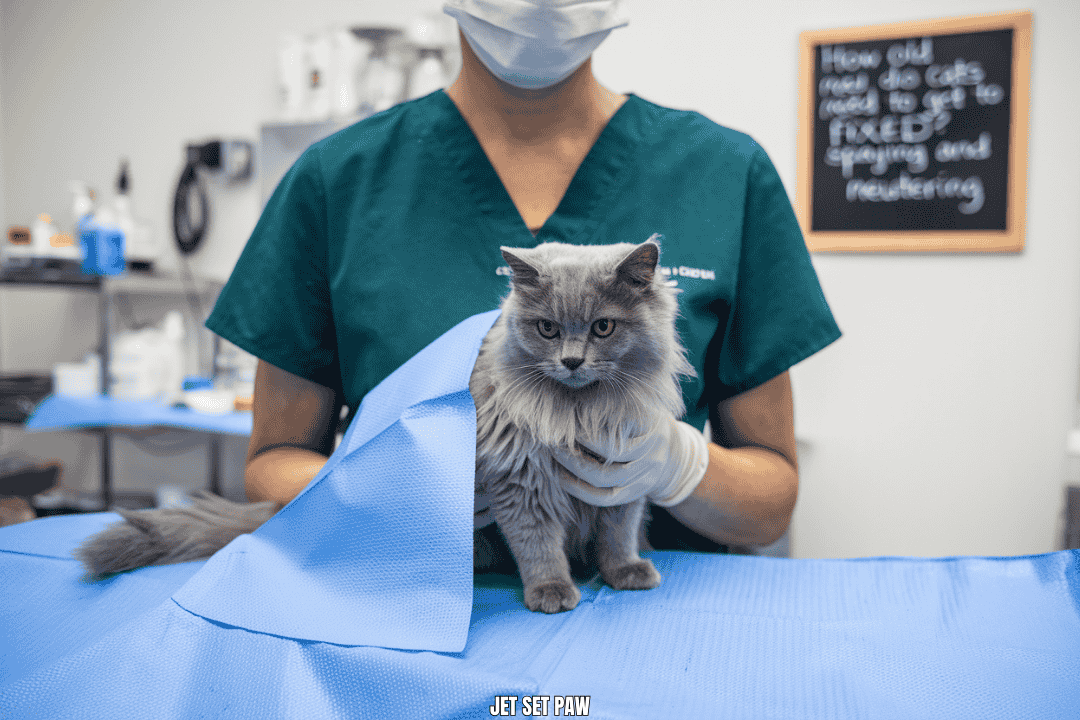When people talk about “fixing” a cat, they refer to a surgical procedure preventing cats from having kittens. For female cats, this is called spaying, which involves removing the ovaries and uterus.
For male cats, it’s called neutering, where the testicles are removed. This process is also known as sterilization.
Getting your cat fixed is super crucial for several reasons. First, it helps control the cat population, reducing the number of stray and homeless cats.
This is crucial because many shelters are already overcrowded. Second, fixed cats tend to be healthier and live longer.
They have a lower risk of certain cancers and other health problems. Lastly, spaying or neutering can improve your cat’s behavior.
Fixed cats are often calmer, less likely to spray to mark their territory, and less prone to fighting with other cats. All these benefits make fixing your cat a responsible choice for pet owners.
The Ideal Age for Fixing Cats
For a long time, veterinarians typically recommended getting cats fixed at around 6 months old. This age was chosen because it’s when cats reach sexual maturity.
By fixing cats at this point, owners could prevent unwanted litters and reduce certain behavioral issues with puberty.
However, there’s been a shift towards earlier spaying and neutering in recent years. Many vets suggest getting cats fixed as early as 8 to 16 weeks old.
This new trend is based on research showing that early fixing is safe for kittens and can have additional benefits. For example, kittens usually recover faster from surgery than older cats.
Also, fixing cats before they reach sexual maturity can prevent some unwanted behaviors from developing in the first place.
It’s important to note that the ideal age can vary depending on your cat’s specific situation. Some vets still recommend waiting until 6 months for certain breeds or individual cats. The best approach is to talk with your vet about what’s right for your kitten.
Early-Age Spaying/Neutering
Early-age spaying/neutering refers to fixing cats when they’re between 6 and 14 weeks old, much earlier than the traditional 6-month mark. Many animal shelters and rescue organizations have started doing this to ensure kittens are fixed before they’re adopted.
Early-age spaying/neutering, a practice gaining popularity, offers several benefits. First, kittens recover from surgery faster than older cats, often returning to their playful selves within a day or two.
Second, it can more effectively prevent unwanted litters, as some cats can get pregnant as early as 4 months old.
Additionally, early fixing can reduce the risk of certain cancers and may help prevent some behavioral problems before they start.
This information empowers cat owners to make informed decisions about their pet’s health and well-being.
However, some people have concerns about early-age fixing. Some worry that it might affect the cat’s growth or development. Others are concerned about increased risks during surgery for such young kittens.
While most studies show that early-age fixing is safe, discussing concerns with your vet is always a good idea.
They can provide the most up-to-date information and help you make the best decision for your kitten based on their health and circumstances.
Factors Affecting the Timing of Fixing
Several factors can influence when it’s best to fix your cat. One of the most important is your cat’s overall health. A veterinarian will always check to ensure your cat is healthy enough for surgery.
If your kitten has any health issues, the vet might recommend waiting until they are resolved before fixing them.
The breed and size of your cat can also play a role in deciding when to fix them. Some larger breeds might benefit from waiting longer to be fixed, as they take more time to grow and develop.
On the other hand, smaller breeds might be ready for the procedure earlier. Your vet can give you specific advice based on your cat’s breed.
Lifestyle is another factor to consider. If your cat spends time outdoors, you might want to fix it earlier to prevent unwanted pregnancies or fighting with other cats.
The timing is more flexible for indoor-only cats. However, fixing indoor cats to prevent behavioral issues and health problems is generally recommended.
Remember, every cat is unique. While these factors are essential to consider, the best approach is to talk with your vet.
Their expertise and understanding of your cat’s situation can help you decide the best time for the procedure, making you feel reassured and responsible as a pet owner.
Special Considerations
When it comes to fixing cats, there are some unique things to consider for female and male cats. For female cats, one significant consideration is their heat cycles.
Female cats can go into heat as early as 4 months old, which can happen several times a year. During heat, female cats may become vocal and restless and try to escape to find a mate.
This behavior can be stressful for both the cat and her owners. Spaying a female cat before her first heat cycle can prevent these issues and reduce the risk of certain cancers.
Male cats have their own set of considerations, mainly related to behavior. Unneutered male cats are more likely to spray urine to mark their territory, which can be smelly and unpleasant in a home.
They’re also more prone to aggression and may try to roam far from home in search of a mate. This can put them at risk of getting into fights with other cats or getting hurt in traffic.
Neutering male cats can help reduce these behaviors, making them calmer and more content as indoor pets. It’s important to remember that while fixing your cat can help with these issues, it’s not a guaranteed fix for all behavior problems.
The Procedure
The surgery to fix a cat is a standard veterinary procedure done under general anesthesia to ensure the cat’s comfort and safety. For female cats, it’s called spaying.
The vet makes a small cut in the cat’s belly and removes the ovaries and uterus. For male cats, it’s called neutering. The vet makes a small cut in the scrotum and removes the testicles.
Both surgeries are done under general anesthesia, which means the cat is asleep and doesn’t feel any pain during the operation. This emphasis on safety can help potential cat adopters feel confident and secure in their decision to spay/neuter their pet.
After the surgery, most cats recover quickly. They usually stay at the vet’s office for a few hours or overnight to ensure everything is okay.
When you bring your cat home, they might be groggy or uncomfortable for a day or two. Your vet will give you instructions on how to care for your cat during recovery.
This often includes keeping them calm and quiet, checking the surgery site for any signs of problems, and maybe giving them some pain medicine.
Most cats are back to their usual selves within a week or so. Following your vet’s advice is vital to help your cat heal properly and avoid complications.
Conclusion
To sum up, the ideal age to fix a cat is usually between 4 and 6 months old. This timing allows the cat to grow a bit but is still early enough to prevent unwanted pregnancies and reduce the risk of certain health issues.
However, many vets now safely perform the surgery on kittens as young as 8 weeks old, especially in shelter situations.
Talking to your veterinarian about when to fix your cat is super important. Every cat is different, and your vet knows your pet’s health best.
They can look at your cat’s size, breed, and overall health to determine the best time for the surgery. Your vet can also answer any questions about the procedure and advise on caring for your cat before and after the surgery.
Remember, fixing your cat is a big step in keeping them healthy and happy for years, so don’t be afraid to ask your vet for guidance.

